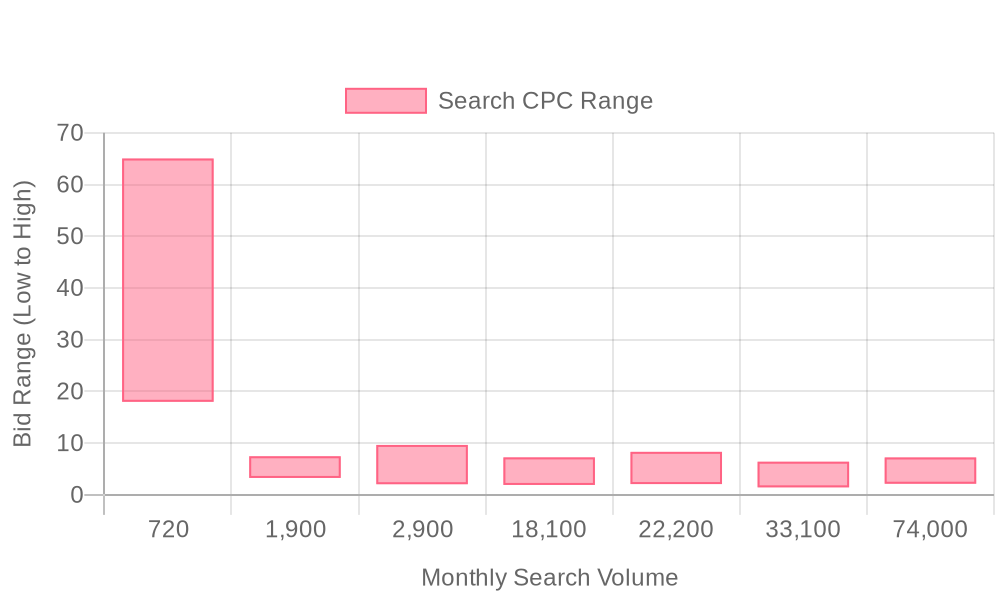
Supercharge your lead generation with a FREE Google Ads audit - no strings attached! See how you can generate more and higher quality leads
Get My Free Google Ads AuditFree consultation

No commitment
Supercharge your lead generation with a FREE Google Ads audit - no strings attached! See how you can generate more and higher quality leads
Get My Free Google Ads AuditFree consultation

No commitment
In today's competitive healthcare landscape, enhancing your medical practice's visibility requires a strategic mix of online and offline channels working together. Online platforms like Google Ads play a crucial role in capturing high-intent prospects at the exact moment they're searching for medical services, effectively bridging the gap between broader awareness efforts and your practice's patient acquisition process. For medical practices, Google Ads is a powerful tool to precisely target potential patients, ensuring your practice is visible when prospective patients are actively seeking healthcare solutions. Modern solutions now allow practices to harness advanced data insights, ensuring they engage with high-value prospects even before they actively reach out.

Medical practices increasingly rely on digital advertising to reach patients who are actively searching for care solutions. With the right Google Ads strategy, clinics can precisely target high-intent patients, minimize wasted ad spend, and accelerate appointment bookings. To see a practical step-by-step guide on setting up effective healthcare campaigns, explore this Google Ads guide for healthcare providers.
Integrating Google Ads into your healthcare marketing mix requires a rigorous, data-driven methodology. Real-time analytics reveal which campaigns are driving the highest-value patient inquiries, empowering practices to allocate budget toward channels and messaging that consistently deliver measurable results. Sophisticated platforms now allow for granular visitor identification, enabling marketers to move beyond general website analytics and pinpoint which company or patient segment is engaging with each ad. This approach shifts the focus from generic impressions to actionable patient engagement, ensuring every dollar is optimized for lead generation and conversion.
Effective Google Ads for Medical Practices hinge on understanding the nuanced intent behind patient searches. Building keyword lists that blend clinical language with layman’s terms—for example, pairing "orthopedic specialist" with "knee pain doctor near me"—expands reach to both informed and symptom-driven patients. Audience targeting extends beyond demographics, leveraging real-time audience signals that indicate when someone is actively seeking care, such as recent visits to healthcare content or engagement with similar provider ads. For additional strategies tailored to medical practices, review this overview of Google Ads for medical practices. Dynamic audience segments automatically update as prospects move from research to booking, keeping retargeting efforts focused on those most likely to convert. When platforms sync enriched audience data across Google Ads and leading CRMs, campaigns consistently reflect the latest insights, adapting in real time to patient behavior changes.
Patient acquisition through Google Ads depends on seamless alignment between ad creative and landing page experience. High-converting campaigns feature messaging continuity, where the promise made in the ad headline is reinforced by clear value propositions and trust signals on the landing page. Conversion rates improve when landing pages load quickly on mobile devices, display relevant provider credentials, and offer frictionless scheduling options. Advanced platforms can tie ad engagement data back to specific landing page outcomes, automatically attributing booked appointments to the right campaigns and keywords. For best practices on optimizing healthcare landing pages, see this healthcare landing page guide. This feedback loop enables healthcare marketers to test new headlines, visuals, and calls to action, refining creative assets based on real patient response data.

Continuous performance optimization is crucial for maximizing Google Ads ROI for healthcare. Automated bid strategies, powered by real-time conversion data, adjust spend based on the likelihood of each click resulting in a patient appointment. By tracking both online and offline conversions—such as form fills and phone calls—practices gain a true picture of advertising impact across the entire patient journey. Integration with CRM systems ensures every lead is tracked from initial ad engagement to final appointment, closing the attribution gap that plagues traditional reporting. For a comprehensive explanation of PPC best practices and compliance, refer to this PPC for healthcare organizations guide. Marketers can then segment results by service line, location, or referral source, uncovering which combinations of keywords, ads, and landing pages are driving the best outcomes.

Achieving sustainable growth with Google Ads for Medical Practices involves orchestrating campaigns across multiple digital touchpoints. Cross-channel audience management ensures that patient segments identified via paid search are seamlessly retargeted on social, display, or email, reinforcing brand presence throughout the decision process. Syncing data across platforms eliminates silos, so audience lists and conversion events stay up to date regardless of channel. By unifying performance metrics and audience signals, revenue teams can identify patterns, optimize spend, and personalize outreach with unprecedented precision, leading to higher patient acquisition rates and lower cost per lead.
In healthcare, the challenge often lies in identifying and engaging high-value prospects who may not convert through traditional forms. Advanced tools feed vital audience segments into your campaigns, ensuring ad spend is focused on leads demonstrating real intent. This approach not only streamlines demand generation but also empowers practices to target, engage, and convert patients more efficiently than ever before. If you’re ready to see this in action, get started for free with Sona.
Healthcare marketing demands a blend of precision and agility to meet patient expectations and business goals. With Google Ads, medical practices can engage high-intent patients the moment they begin searching for specific treatments or providers, resulting in more relevant connections and faster appointment bookings. For a step-by-step walkthrough, see this guide to setting up Google Ads for healthcare, which is especially useful for clinics new to digital advertising.
Timing is critical in healthcare marketing. Practices that harness real-time intent signals and dynamic audience updates can engage leads at the perfect moment, moving patients swiftly from search to scheduled visit and ensuring every opportunity for growth is captured. If you're ready to streamline your audience targeting and measurement, get started for free with Sona.

Understanding each format’s role in the patient journey allows B2B revenue teams to create Google Ads for Medical Practices strategies that engage new prospects at every step, from initial search to long-term loyalty. With a unified platform approach, medical organizations can ensure their advertising stays relevant, compliant, and measurable—accelerating patient acquisition and maximizing ROI. For teams ready to elevate their healthcare ad strategy, get started for free with Sona.

Expanding your patient reach requires a strategic approach that identifies untapped segments and channels. Modern healthcare practices can amplify growth by leveraging advanced digital insights to capture high-intent audiences that traditional marketing often overlooks. For clinics new to digital advertising, a step-by-step guide for Google Ads in healthcare can provide valuable direction on campaign setup and compliance.
Analyzing competitor strategies and integrating real-time behavioral data reveal growth pockets that standard campaigns overlook. By unifying these insights with targeting and retargeting efforts, medical practices consistently identify and capture high-value patient opportunities, maximizing every dollar invested in Google Ads for healthcare. If you’re ready to take the next step, get started for free with Sona.
Medical practices thrive when marketing efforts are mapped precisely to the patient journey. Audience segmentation is the foundation for aligning outreach to clinical needs, ensuring that messages resonate with the right individuals at the right time. For a deeper dive into healthcare audience strategy, explore this overview of Google Ads strategies for medical practices.
Disconnected or static segmentation often leads to wasted impressions and irrelevant outreach. Medical practices that leverage integrated analytics and dynamic audience management can connect every message to a verified intent signal, driving measurable lifts in conversion rates and marketing ROI. Ready to take your segmentation and analytics to the next level? Get started for free with Sona.

| Industry | Keyword | Monthly Search Volume | Competition Level | Low Bid | High Bid |
| Medical Practices | medical billing services for small practices | 720 | LOW | 18 | 65.02 |
| Medical Practices | village family practice | 1900 | LOW | 3.27 | 7.46 |
| Medical Practices | medical practices | 2900 | LOW | 2.06 | 9.65 |
| Medical Practices | family practice near me | 18100 | LOW | 1.92 | 7.24 |
| Medical Practices | family medicine near me | 22200 | LOW | 2.09 | 8.32 |
| Medical Practices | family practice | 33100 | LOW | 1.46 | 6.41 |
| Medical Practices | family medicine | 74000 | LOW | 2.15 | 7.23 |
Modern medical practices face a unique challenge: capturing high-intent patients in a fragmented digital landscape. A refined keyword strategy for Google Ads for Medical Practices is essential for surfacing your services precisely when prospective patients are searching for care, optimizing every marketing dollar for measurable patient growth. For a step-by-step approach, review this guide to setting up Google Ads for healthcare.
Strategic keyword selection starts with a deep dive into patient search behavior. Effective campaigns blend broad medical service terms—such as “primary care physician near me”—with granular, condition-specific queries like “urgent pediatric asthma treatment” or “same-day sports injury clinic.” This approach ensures reach across both early research and immediate-need intent, balancing volume and quality for patient acquisition through Google Ads. By layering in negative keywords such as “free advice” or “medical school,” practices avoid wasted spend on non-converting clicks; for a practical resource, download a negative keyword list for medical advertising.
Precision targeting is fundamental for healthcare advertising. By using intent signals and geo-modifiers, such as “orthopedic surgeon downtown Houston” or “telemedicine consults in Florida,” clinics can engage patients at the moment of decision and avoid irrelevant impressions outside their service areas. As patient journeys become more data-rich, marketers leverage platforms that identify not just anonymous clicks but verified company and individual visitors.
Measurable ROI is critical for medical practice advertising. Practices need to follow the patient journey from initial click to confirmed appointment or procedure. Integrating advanced conversion tracking—such as offline appointment confirmations and CRM-connected attribution—delivers a complete view of true marketing impact. Connecting Google Ads and CRM systems also enables practices to sync enriched audiences, ensuring that retargeting efforts only engage qualified leads and that sales teams can act quickly on high-intent inquiries.
Channel synergy further elevates results in multi-channel strategies. While social media and email nurture relationships, Google Ads captures the crucial moment of active search. By retargeting website visitors across search, display, and video, and syncing audiences between platforms, practices maintain visibility with high-potential patients until they are ready to book. Automated audience updates ensure that messaging and offers evolve as prospects shift from research to appointment, maximizing conversion rates and streamlining the patient acquisition funnel. Predictive modeling and real-time intent data allow revenue teams to prioritize spend on the most promising segments. To see this approach in action, get started for free with Sona.
Precision in keyword selection is foundational for Google Ads for medical practices. Start by clustering keywords based on specialties, conditions treated, or specific procedures. For example, segmenting campaigns for orthopedic surgery, allergy testing, or pediatric care allows for granular control and message personalization. Localized keyword modifiers such as city names or neighborhoods boost relevance and improve ad rank in local searches. Incorporating negative keywords is essential: by excluding queries like "free clinic" or "medical school," you prevent budget wastage from unqualified clicks.
Advanced data platforms allow marketers to move beyond anonymous search intent by connecting website visits to known organizations or potential patient segments. This means you can prioritize high-intent accounts, dynamically updating audiences as new leads engage with your content or progress through the patient journey. By integrating these signals into your keyword and audience strategy, you continuously refine targeting and maximize spend efficiency.
Effective ad copy in medical practice advertising must spotlight the unique benefits patients receive, such as rapid appointment scheduling, telehealth options, or board-certified care. Highlighting certifications and trust signals reassures patients about quality and compliance. Calls to action like “Book Your Consultation Today” or “Speak to a Specialist Now” drive urgency and direct next steps.
Leveraging real-time behavioral data, marketers can align messaging with specific interests and readiness to convert. For example, if patient intent signals reveal an uptick in searches for sports injury treatment, ads can instantly adjust to promote that service line. Dynamic ad frameworks ensure creative assets and offers remain relevant as patients move from research to appointment booking, increasing conversion rates and optimizing budget allocation.
Landing pages for Google Ads in healthcare must deliver a seamless transition from ad click to relevant information. Each page should immediately answer the query that prompted the ad, featuring clear service descriptions, provider bios, patient FAQs, and prominent calls to action like “Request an Appointment” or “Call Now.” Best practices for healthcare landing pages can help ensure your pages are optimized for conversions.
Integrating offline and online data sources allows you to personalize landing experiences based on previous interactions, ensuring returning visitors see relevant content updates or reminders to complete appointment scheduling. Automated systems can sync CRM data with ad platforms, so audiences receive tailored follow-ups, whether they engaged online or by phone. This approach closes the loop between marketing and operations, capturing every conversion opportunity.
Continuous optimization is critical for maximizing Google Ads ROI for healthcare. Analyze conversion data regularly to identify top-performing keywords, ad variations, and audience segments. Import offline events—such as phone call appointments or in-office visits—back into your ad platform to measure true campaign impact, leveraging insights from PPC for healthcare.
Unifying online and offline conversion tracking enables smarter budget decisions and more accurate attribution. When marketers sync enriched CRM data with Google Ads, they gain clarity on which campaigns drive high-value patient actions, not just clicks. As campaign data accumulates, automated optimization tools can shift spend toward segments showing real purchasing intent or higher lifetime value, ensuring resources are allocated for maximum impact and sustainable growth. To see these strategies in action, get started for free with Sona.
Expanding your medical practice’s digital footprint demands a strategic mix of patient-centric content, intelligent data activation, and real-world relationship-building. Modern practices that align their marketing and operational data achieve faster, more sustainable growth by responding to patient needs in real time and adapting outreach with measurable precision. Explore more on marketing analytics and revenue growth to strengthen your foundation.
Synchronizing your online and offline marketing efforts gives you a holistic view of patient acquisition and engagement. This unified perspective empowers your team to make confident, data-driven decisions about where to expand, which services to prioritize, and how to continually refine your approach for maximum reach and impact. Get started for free with Sona.
As we draw to the end of our deep dive into leveraging Google Ads for medical practices, it's clear that digital advertising holds immense potential for transforming your patient outreach efforts. By understanding how to strategically utilize Google Ads, you can significantly enhance your online visibility, attract new patients, and effectively promote your medical services.
Navigating the complexities of Google Ads can seem daunting, but with the right approach, these tools become powerful assets in your marketing arsenal. We've explored key strategies, from targeting the right audience to crafting compelling ad copy and optimizing your budget. These insights equip you with the knowledge to overcome common challenges and achieve your marketing goals.
Imagine a future where your medical practice stands out online, effortlessly connecting with patients who need your expertise. By taking action and implementing the strategies discussed, you're not just staying ahead in the competitive healthcare landscape—you're ensuring that your practice thrives.
To truly harness the power of data and drive actionable insights, consider integrating a platform that unifies your go-to-market strategies. Start for free to experience our platform's capabilities and see how it can elevate your practice's digital presence today.
To set up Google Ads for your medical practice, it's essential to follow a strategic, data-driven approach that includes building targeted keyword lists, developing compelling ad copy, designing effective landing pages, and continuously optimizing performance using real-time analytics and conversion tracking.
The best strategies for Google Ads in healthcare involve precise keyword targeting combining clinical and layman terms, audience targeting based on real-time intent signals, seamless alignment of ad creative with landing pages, and continuous performance optimization through integration with CRM and analytics tools.
Yes, Google Ads is effective for attracting new patients by engaging high-intent prospects at the moment they search for specific healthcare services, which leads to more relevant connections and faster appointment bookings.
The cost of running Google Ads for doctors varies based on factors like targeting, keyword competitiveness, and the specific services promoted, but practices can optimize spend by focusing on high-margin offerings and leveraging automated bid strategies.
Ensuring HIPAA compliance in Google Ads involves protecting patient data and using platforms that securely integrate audience data, ensuring that any tracking or analytics do not expose personal health information.
Join results-focused teams combining Sona Platform automation with advanced Google Ads strategies to scale lead generation

Connect your existing CRM

Free Account Enrichment

No setup fees
No commitment required

Free consultation

Get a custom Google Ads roadmap for your business
Join results-focused teams using Sona Platform automation to activate unified sales and marketing data, maximize ROI on marketing investments, and drive measurable growth

Connect your existing CRM

Free Account Enrichment

No setup fees
No commitment required

Free consultation

Get a custom Google Ads roadmap for your business
Over 500+ auto detailing businesses trust our platform to grow their revenue
Join results-focused teams using Sona Platform automation to activate unified sales and marketing data, maximize ROI on marketing investments, and drive measurable growth

Connect your existing CRM

Free Account Enrichment

No setup fees
No commitment required

Free consultation

Get a custom Google Ads roadmap for your business
Over 500+ auto detailing businesses trust our platform to grow their revenue
Join results-focused teams using Sona Platform automation to activate unified sales and marketing data, maximize ROI on marketing investments, and drive measurable growth

Connect your existing CRM

Free Account Enrichment

No setup fees
No commitment required

Free consultation

Get a custom Google Ads roadmap for your business
Over 500+ auto detailing businesses trust our platform to grow their revenue
Join results-focused teams using Sona Platform automation to activate unified sales and marketing data, maximize ROI on marketing investments, and drive measurable growth

Connect your existing CRM

Free Account Enrichment

No setup fees
No commitment required

Free consultation

Get a custom Google Ads roadmap for your business
Over 500+ auto detailing businesses trust our platform to grow their revenue
Our team of experts can implement your Google Ads campaigns, then show you how Sona helps you manage exceptional campaign performance and sales.
Schedule your FREE 15-minute strategy sessionOur team of experts can help improve your demand generation strategy, and can show you how advanced attribution and data activation can help you realize more opportunities and improve sales performance.
Schedule your FREE 30-minute strategy sessionOur team of experts can help improve your demand generation strategy, and can show you how advanced attribution and data activation can help you realize more opportunities and improve sales performance.
Schedule your FREE 30-minute strategy sessionOur team of experts can help improve your demand generation strategy, and can show you how advanced attribution and data activation can help you realize more opportunities and improve sales performance.
Schedule your FREE 30-minute strategy sessionOur team of experts can help improve your demand generation strategy, and can show you how advanced attribution and data activation can help you realize more opportunities and improve sales performance.
Schedule your FREE 30-minute strategy session





Launch campaigns that generate qualified leads in 30 days or less.
